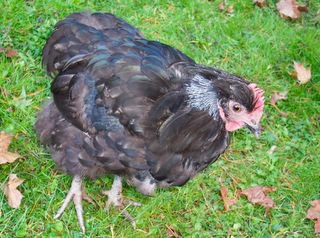
OK, so you're enjoying your first season of small scale urban poultry farming and then in the Spring or the Fall after your birds have been around for about a year, you go outside one day to find your hens look a little shaggy...and seem to be losing neck and tail feathers...until one day they look almost exactly like Harriet, pictured above.
Is it some bizarre parasite or mite? Does your hen need medication or a good bath? No, it's just a molt, the shedding of old feathers and replacement with new feathers. Quite frankly we haven't figured out what the cycle is, because half the flock molted in the Spring, and some unlucky few are going through it now in the Fall--while it's rather chilly out!
Although Harriet looks pretty raggy, she's actually on the feather growing side of things, thus all the weird pokey looking things on her neck--those are called pin feathers. She still losing a few of her body feathers, but for the most part that has slowed down and new feather growth is beginning.
During this phase of feather growth, chickens require more protein to support the additional feather development, and they usually stop laying during molting. We typically try to increase cultured dairy, give more seeds, and also supplement with occaisional raw meat. (If you're a new visitor, please see my previous posts on this--chickens are not vegetarian. They will eat any protein they can beg, steal or hunt.)
I remember a more experienced chicken enthusiast warning me about the first molt--but even so, when our first hen began molting I was worried it was feather mites or some such thing. At night Michael and I went in to the coop, and while the poor molting hen was sleeping we accosted her with diatomaceous earth (like forcing a dust bath). In the end she didn't really mind it, and probably enjoyed the mid-rainy season dust bath--but it didn't stop the molting!





